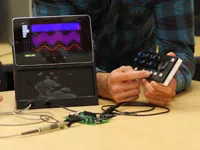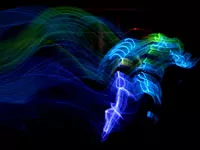
Industry needs fresh perspectives and ideas to keep inventing the future. Where better to find these fresh ideas than among the students of top engineering universities? The Oregon State CreateIT Collaboratory in the School of Electrical Engineering and Computer Science endeavors to do just that. Using hands-on real projects, select groups of students take radical ideas from industry and research and develop them to prototypes. The Collaboratory creates work-ready graduates who can successfully work on a team to create new products.
Student interns are hired in small teams to work on a specific project with a client. These students leverage their own excitement, OSU’s technical excellence, and industry guidance to create things that have never been seen before. Clients so far include Tektronix, Texas Instruments and the Utah Ballroom Dance Company.
The CreateIT Collaboratory was started with seed funding from The Tektronix Foundation which has a decades-long partnership with Oregon State to give students work-relevant experiences.
To find out how to become part of the Collaboratory as a client or student, contact Don Heer.
Current Projects
SMART Helmet
The Collaboratory is working on the cutting-edge technology of wearable computing for a project to improve safety. Imagine a bicycle helmet that can call 911 and relay information about the impact a rider just experienced. This SMART helmet can report the type and severity of the injury to help diagnose a concussion. An onboard GPS can even be used to track your child’s trips! The project was featured in Scientific American and The Register (UK).
Music and Emotion
The power of music to affect our emotions is the topic of Oregon State professor, Jason Silveira’s research. The Collaboratory is working with him to understand music response at a deeper level. This project will develop a system to measure skin conductance in response to music, advancing technology for research in music perception. Read more about the project in the article, "Art Meets Engineering."
The Six Sense
Have you ever sensed that someone was behind you without looking? This project with Texas Instruments will develop technology to allow a user to “feel” nearby objects. Applications include navigating in complete darkness or through fog and smoke. Drivers could be able to sense where other cars are located without looking. Using human neuroplasticity, the system teaches the brain to understand new information. The data collar can then interact with many different types of data to inform the brain of its surroundings.
User-Friendly Oscilloscopes
Tektronix will soon be launching a major redesign of their oscilloscopes and are looking to incorporate the work of the Collaboratory team to improve their usability. Widely used in science and engineering, oscilloscopes measure and analyze electrical signals. The team has already presented Tektronix with two prototypes of fingerprint scanners that allow users to save and retrieve oscilloscope settings. Further work will develop a control interface for Android smartphones to manipulate the oscilloscope as well as mange settings.
Completed Projects
Oscilloscope Interface

Tektronix funded the project to modernize the interface for oscilloscopes that currently use knobs and buttons to navigate menus and manipulate data. The Collaboratory group developed a concept interface that makes use of modern technology like touch screens, wireless design controls, and voice recognition.
Light-up Dance Suit

The Utah Ballroom Dance Company worked with a Collaboratory team to develop their version of a light-up dance suit as seen on shows like “America’s Got Talent.” Although other dance groups have developed their own devices, no one has produced them for the market. The dance company will take the suits on tour and the Collaboratory team is further developing the suits for the market. View the team's video.